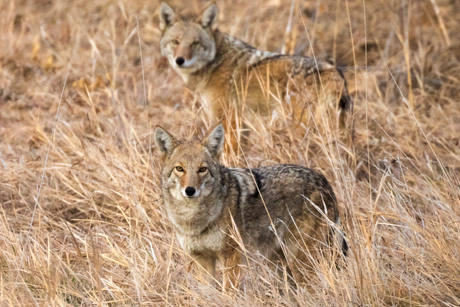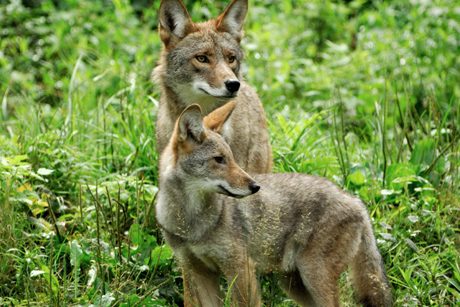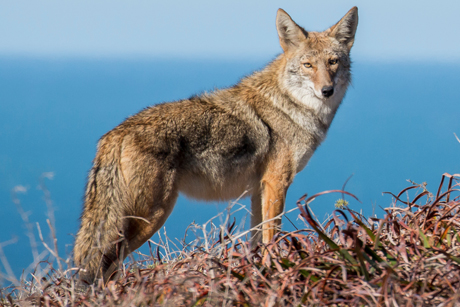


Listen to coyotes singing:







Services we offer:
- Municipal Coyote Response Plans
- Coyote Task Forse support and training
- Population surveys, yard and neighborhood audits
- Animal removal, eviction, exclusion
- Predator-proof fencing, barriers, enclosures
- Aversion conditioning, humane hazing
- Educational presentations (in-person and Zoom)
Coyotes do not consider humans prey.
Unprovoked bites are extremely rare.
Learn about the California Valley Coyote, HERE.
Important coyote facts at a glance
→ Western Coyote weighs ~ 20-30 lbs., Eastern, ~ 30-45 lbs.
→ Coyotes can live solitary lives or be a part of a Family Group.
→ Family Groups usually consist or 2 - 5 adults.
→ Coyotes are 100% monogamous. Until death do they part. ♥
→ Only the Matriarch and Patriarch ("king and queen") reproduce.
→ Fertility in subordinate females is behaviorally suppressed.
→ Coyotes fiercely defend territories.
→ Urban territories can be as small as a half square mile.
→ Coyotes usually hunt alone or in loose groups.
→ Coyotes are opportunistic omnivores.
When the song-dog sings
When most people hear a group of coyotes howling and yipping, it can sound like there are six or more individuals, when really it might just be the Alpha pair. This phenomenon is called the “beau geste” effect.
Read and learn more about coyote vocalizations HERE and HERE.
Coyote sighting
It's not unusual to see or hear a coyote during the day. They scavenge and hunt for food both day and night, preferring to minimize interactions with people or other predators.
Repeated sightings of coyotes in an urban area can indicate a reliable source of food. Common attractants include pet food, garbage, compost, fallen fruit, birdseed (and the rodents attracted to it), poison bait stations (and dead or dying rodents), feral cats and their food.
Coyotes loitering in an area, repeatedly, may indicate a nearby source of food, or that pups are nearby.
Coyote encounter in an urban landscape
Coyotes have a natural fear of humans and are easily chased off. However, they can learn to tolerate being close to humans when "rewarded" with food - when the juice is worth the squeeze.
Food conditioning happens when a coyote finds a reliable source of food in, for example, a neighborhood. The coyote will still be very shy of humans.
Coyotes can become human conditioned to people after repeated encounters that result in food "rewards". They learn to associate humans with handouts. A human-conditioned coyote will tend to approach people. See an example, HERE.
Human-conditioned coyotes may even try to nip to acquire food. This "demand" behavior is similar to the jackals in Africa that will follow lions because they have learned lions lead to food.
Food and or human conditioning is reversible!
Aversion Conditioning
Aversion conditioning, which includes humane hazing, is a suite of techniques and tools used to maintain healthy boundaries between humans and wildlife. If you have ever protected your dinner plate from your canine companion, you have effectively hazed a canid.
We recommend reading this paper on humane hazing, HERE, and then check out our aversion conditioning best practices, HERE.
It may also be helpful to watch this instructional video, HERE.
Hazing Props:
- Scare Stick (stick with mylar flashing). Learn more, HERE.
- Large garbage bag (snap it in the air)
- Umbrella (open it toward coyote)
Territoriality and Protectiveness
In spring and summer, coyotes with pups may become especially protective, and reactive towards dogs. They will tend to follow or "shepherd" people walking dogs to escort them away from their pups. See how to prevent close encounters below.
Removal
There are some who believe if they can rid their neighborhood of coyotes, they'll be "safe" - but that's not the case. When coyotes are removed, new individuals from the surrounding area quickly fill the vacancy. One minus one equals one.
This strategy, sometimes considered by municipalities in an attempt to answer concerns by their constituents and promoted by conventional wildlife control tradesmen ($$$$), delivers a false sense of security at taxpayer expense.
In some cases, removal of coyotes can increase their numbers when one or both of the pack leaders are killed. The subsequent dissolution of the pack's social structure results in a cascade of negative impacts. Without the male and female - the "king" and "queen" to defend their territory, new coyotes will have an opportunity to move in. Oestrus in subordinate females will no longer be suppressed, which could potentially result in more litters the following spring, depending on how the territory is divided.
Bottom line, removal of coyotes in an attempt to reduce their presence or their numbers has never been effective.
Check out this video explaining why, HERE.
What works
Research has proven, reducing anthropogenic sources of food in a community will result in a decrease coyote sightings and fewer coyotes overall. Read more about the work conducted by Narragansett Bay Coyote Study (NBCS), HERE. Read a recent article, HERE.
The presence of coyotes in an urban area indicates they are being attracted to and supported by a reliable source of food. The key to reducing their presence, then, is to reduce or eliminate the food resources they are dependent upon.
In addition to reducing food attractants, aversive conditioning can establish and maintain healthy boundaries.
Ultimately, it will be the people who will keep coyotes out of neighborhoods by not welcoming their presence. By each individual doing their part.
For communities with a high presence of coyotes, we recommend instituting a Coyote Response Plan. Check out our video that explains what a response plan includes, HERE.
Safety tips for small dog owners
Coyotes view other canids as competition. If you encounter a coyote while walking your dog, the coyote(s) may not scare off easily. Please read our aversion conditioning best practices thoroughly, HERE.
Where coyotes are prevalent, always walk your dog(s) on a leash no longer than 6 feet.
Preventing pet and livestock losses
Responsible custodianship is key to preventing injury and loss of pets and livestock. The onus is on small pet owners and livestock produces to protect their animals from predators, just as they would (or should) protect their animals from the weather.
If you have recently lost an animal to a coyote or are finding it difficult to protect your animals, you may qualify for free assistance. Find out more about the Coyote Challenge, HERE.
Interspecific interactions
Coyotes are very curious and very playful - and impartial about whom or what is willing to engage in play.
HERE's the famous video of a coyote and badger heading out for a jaunt.
HERE, a wild coyote and airedale play in the streets. In this video, HERE, a wild coyote engages playfully with a hound. HERE's a lovely video of a coyote making a connection with a human, and HERE, another playful greeting.
More resources:
Coyotes Among Us, Stan Gehrt
Coyote America, by Dan Flores
Coyote Conversations: Aversion Conditioning
